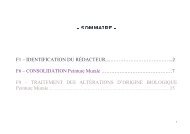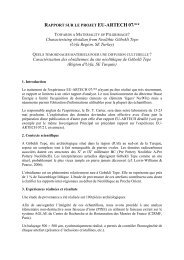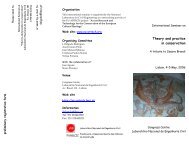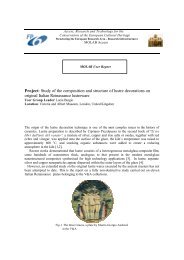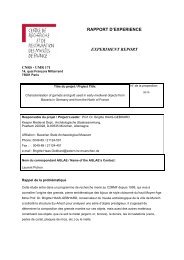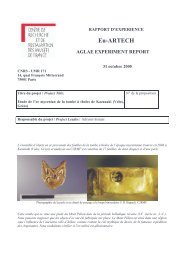JRA2 XRD portable (18 months) - Eu-ARTECH
JRA2 XRD portable (18 months) - Eu-ARTECH
JRA2 XRD portable (18 months) - Eu-ARTECH
Create successful ePaper yourself
Turn your PDF publications into a flip-book with our unique Google optimized e-Paper software.
SECOND ANNUAL REPORT - DELIVERABLE N. 34<br />
<strong>JRA2</strong>-Task 3- Progress report on optimal conditions<br />
for <strong>XRD</strong> studies<br />
(<strong>18</strong> <strong>months</strong>)<br />
<strong>Eu</strong>-<strong>ARTECH</strong><br />
Access, Research and Technology for the conservation of<br />
the <strong>Eu</strong>ropean Cultural Heritage<br />
Integrating Activity<br />
implemented as<br />
Integrated Infrastructure Initiative<br />
Contract number: RII3-CT-2004-506171<br />
Project Co-ordinator: Prof. Brunetto Giovanni Brunetti<br />
Reporting period: from June 1 st 2005 to May 31 st 2006<br />
Project funded by the <strong>Eu</strong>ropean Community<br />
under the “Structuring the <strong>Eu</strong>ropean Research Area”<br />
Specific ProgrammeResearch Infrastructures action
<strong>JRA2</strong> Task 3 - Report on optimal conditions for artwork <strong>XRD</strong> studies and <strong>XRD</strong> and XRF<br />
assembling<br />
Resp. C2RMF – A.Gianoncelli, J.Castaing<br />
Introduction<br />
The complete knowledge of materials characteristics requires the determination of the different phases<br />
(chemical composition, crystal structure) that are present in an object and the description of the<br />
microstructure (grain size, texture, lattice imperfections, etc.). The target of the project is to obtain this<br />
information thanks to a new tool for in situ studies of the constitutive materials of artworks by means of X<br />
ray fluorescence (XRF) and X ray diffraction (<strong>XRD</strong>). In the first twelve <strong>months</strong>, an assessment of the<br />
possible geometries has been made and general specifications have been established. We ruled out the<br />
energy dispersive X ray diffraction (ED-<strong>XRD</strong>) option based on a literature survey. However, we performed<br />
diffraction experiments to compare the performance of ED-<strong>XRD</strong> with traditional angular detection; we<br />
present the first results that confirm our initial choice.<br />
Another choice has been made concerning the detection of diffracted beams; we purchased an imaging plate<br />
system and have started to test it for <strong>XRD</strong> recording.<br />
Energy dispersive X-ray diffraction experiments<br />
Energy Dispersive X-ray diffraction (ED-<strong>XRD</strong>) experiments have been carried out at the Laboratoire de<br />
Cristallographie (CNRS UPR 5031) in Grenoble in order to test the performance of this method for a<br />
<strong>portable</strong> <strong>XRD</strong> instrument.<br />
X-ray diffraction occurs when there is constructive interference between incident and diffracted waves; this<br />
means that the path difference between the two waves must be an integer number of wavelengths.<br />
This leads to the Bragg’s law:<br />
2 d sin ϑ = nλ<br />
= n (1.24 / E)<br />
where d is the spacing between the planes in the atomic lattice<br />
is the wavelength of the incoming x-ray of energy E (in keV for in nm)<br />
n is an integer<br />
¡ is the angle between the incident beam and the scattering planes.<br />
Angle dispersive methods rely on the identification of the angles ¡ corresponding to constructive<br />
interference, once has been fixed.<br />
Energy dispersive methods allow to recognise the crystal structure of the sample (d-spacing) by analysing the<br />
energy of the peaks present in the spectra, acquired at a fixed angle ¡ .<br />
The following instrumentation was used during the test:<br />
- Cu anode X-ray tube biased at 40 kV and 40 mA;<br />
- Si(Li) detector, 8 ¢ s peaking time, nominal energy resolution of <strong>18</strong>0 eV @ Mn K£ line (5.898 eV).<br />
- Goniometre to rotate detector and sample independently<br />
A few different specimens have been analysed: polycrystalline silicon, quartz, calcite and calcite covered by<br />
a thin layer of goethite.<br />
The measurement have been taken at two or three different 2¡ angles for each sample; this results in a shift<br />
of the peak position (energy) by changing the angle.<br />
We show the results obtained for polycrystalline silicon (figures 1 and 2). The position of the peaks for<br />
Polycristalline Si is indicated in table 1, according to the crystalline plane and to the angle between X-ray<br />
beam and detector axis (2¡ ).<br />
Due to difficulties in the alignment of the system, the geometry of the experiment is not well known, in fact<br />
the detected peaks correspond to the angles indicated 2θ=31° and 2θ=36°.
hkl<br />
d-spacing<br />
[Å]<br />
Table 1.<br />
position [keV]<br />
@ 31°<br />
position [keV]<br />
@ 36°<br />
111 3.1355 7,398 6,398<br />
220 1.9201 12,081 10,448<br />
311 1.6374 14,167 12,252<br />
400 1.3567 17,098 14,787<br />
331 1.2459 <strong>18</strong>,619 16,102<br />
422 1.1085 20,927 <strong>18</strong>,097<br />
This kind of sample is an ideal one because its fluorescence peaks are in the low energy range (Si K£ is at<br />
1.740 keV); in this way the diffraction peaks can only interfer with the Cu peaks due to the anode of the Xray<br />
tube. The Si peaks are not visible in the spectrum because of the absorption of the air (the distance<br />
between sample and detector is around 15 cm).<br />
For most complicate or multi-elemental samples, the overlapping of fluorescence and diffraction peaks can<br />
make the peak identification more difficult.<br />
Figures 1 and 2 show the spectra acquired at two different angles. Peaks have been identified as diffraction<br />
peaks: the corresponding crystalline plane is indicated in the spectra.<br />
- Figure 1. Spectrum of a polycristalline Si, acquired with the Si(Li) detector and 2¡ 1=30°;<br />
measurement time (real time): 150 sec
- Figure 2. Spectrum of a polycristalline Si, acquired with the Si(Li) detector and 2¡ 1=35°;<br />
measurement time (real time): 150 sec<br />
As expected, by changing the 2¡ angle, the diffraction peak energy changes. For instance, the (111) peak is<br />
included in the fluorescence Cu-Kα in figure 1 and it is visible in figure 2, but it coincides with the escape<br />
peak.<br />
Similar observations were made on the other compounds. In these cases, the fluoresecnce of Ca and Fe from<br />
the specimens add up to the fluorescence of copper that originates from the X ray source.<br />
Although the measurements showed that it is possible to identify the diffraction peaks by using energy<br />
dispersive methods, this technique does not seem suitable for mineral identification with a <strong>portable</strong><br />
instrument. The diffraction peak intensity is quite weak and the peak width is quite large, due to the detector<br />
energy resolution and to the superposition of different diffraction peaks.<br />
Fluorescence peaks can strongly interfere with diffraction peaks making their identification more difficult.<br />
Moreover fluorescence peaks are usually much more intense than diffraction ones.<br />
In principle these problems could be overcome by systematically doing measurements at several different<br />
angles. This could be done in a relatively quick measurement time by using a multi-element detector or some<br />
single detectors located at different 2θ angles. This solution would allow to evaluate the geometry and to<br />
separate diffraction and fluorescence peaks. On the other hand this requires a complex and heavy equipment,<br />
and also a non-trivial data analysis.<br />
This supports our initial conclusion, based on the literature, to rule out the ED-<strong>XRD</strong> for the planned <strong>portable</strong><br />
system.<br />
X-ray Diffraction experiments with Imaging Plate<br />
The experiments have been performed at the Laboratoire de Cristallographie (CNRS UPR 5031) in<br />
Grenoble. The source used is a Philips C-Tech type x-ray tube, with Cu anode and a maximum power of<br />
2200 W (60 kV). The x-ray beam is monochromatic by means of two mirrors: only Kα1, Kα2 and Kβ appear<br />
in the spectrum (with approximately the following ratio between intensities Kα/Kβ≈10 -3 ÷10 -4 ).<br />
The divergence of the beam is approximately 0.05° and its dimension is around 1.5mm x 1mm in the centre<br />
of the goniometer, with a flux of around 10 7 ph/s.<br />
The tube is biased at 50 kV and 40 mA.<br />
Different kinds of samples and different times of measurement have been taken into account in order to test<br />
the system.<br />
For each sample two <strong>XRD</strong> detector systems have been used:<br />
- a conventional scintillator detector, with a monochromator in front of it, in a θ-2θ configuration
- an Imaging Plate (IP) perpendicular to the incident X-ray beam at distance of around 20 cm from<br />
sample, with ω being the angle between x-ray beam and sample surface.<br />
Here, we present the results obtained for quartz. For a measurement time less than 5 min the IP scanner did<br />
not read anything.<br />
Since the first image with the fixed sample showed some preferential orientation (punctuation on the rings)<br />
of the crystals in the quartz, further measurements were taken with the sample turning on itself in order to<br />
obtain a more uniform diagram (figure 3).<br />
Figure 4 and 5 show a comparison between the diagram recorded by the scintillator detector (1h and 6<br />
minute measurement) and the diagram obtained from the fitting (Fit2D) of the image recorded with the<br />
Image Plate (10 minutes), respectively. Considering the measurement times and the intensity shown in the<br />
diagram, the efficiency of the imaging plate appears quite high.<br />
Figure 3. Diagram recorded on the imaging place for a turning quartz sample irradiated for 10 min with a<br />
monochromatic radiation (Cu K£ ) and ω=15°, read at 16 bit.<br />
Figure 4. θ-2θ <strong>XRD</strong> diagram for quartz, recorded with a scintillator detector over a 2θ range from 20° to 60°<br />
(0,05°/step with 5s/point) for a total measurement time of around 1h and 6 minutes.
Figure 5. Result of the fitting of an <strong>XRD</strong> diagram recorded with an imaging plate, for a quartz sample<br />
irradiated for 10 min and =15° (16 reading bits).<br />
The imaging plate detector proved to be a valid alternative to the one-dimensional scintillator detector: the<br />
measurement times are comparable (around 20÷30 minutes for both), even if imaging plate seems to be more<br />
efficient. Imaging plates have the big advantage of being a two-dimensional low-noise system, with a<br />
flexible mounting and wireless, and they allow to collect data in a parallel detection configuration. On the<br />
other hand the scanner system requires around 3 minutes to read the recorded image (it is not an online<br />
measurement; the result is visible only at the end of the process) and imaging plates are light sensitive.<br />
Further tests are in progress in order to determine the needs for an analyzer for the diffracted beams and the<br />
types of slits/diaphragms necessary for optimal <strong>XRD</strong>. This is will allow to choose the optimal X ray source<br />
compatible for XRF and <strong>XRD</strong>.





